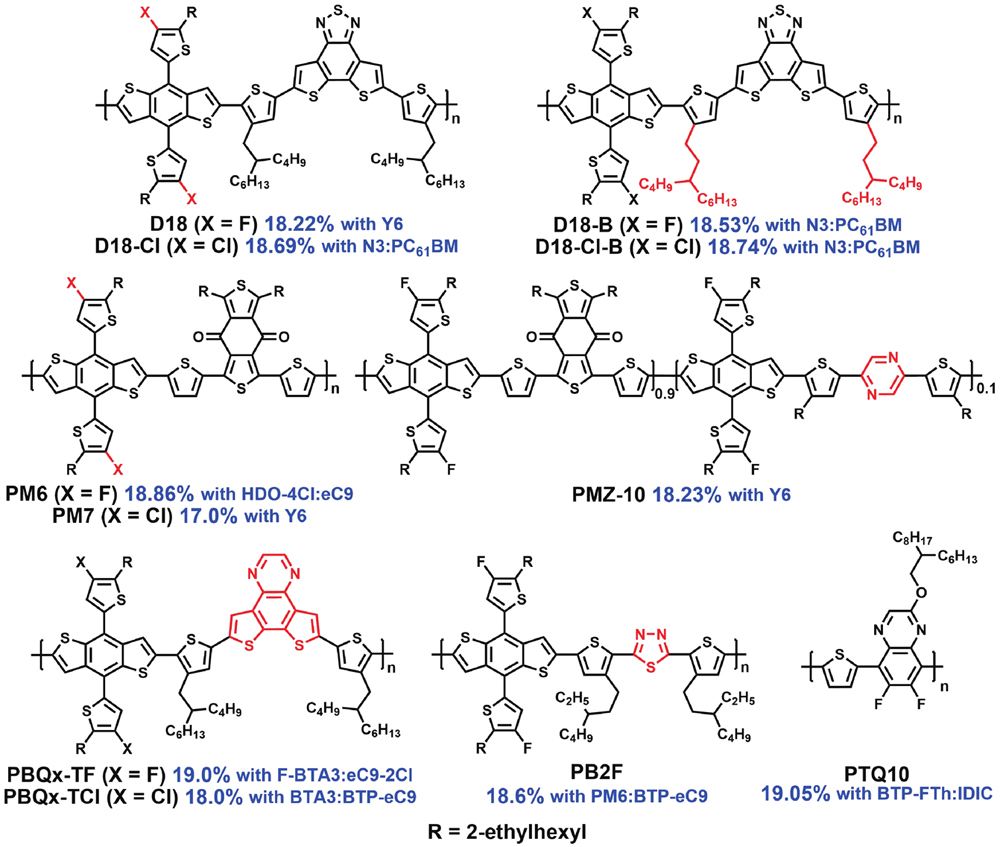In 2015, a nonfullerene acceptor (NFA) ITIC was reported by Zhan et al., bringing OSC to a new era. Many efficient NFAs have been developed, and the PCEs of solar cells have soared to ~19%[
- Journal of Semiconductors
- Vol. 43, Issue 7, 070201 (2022)
Abstract
Currently, most efficient polymer donors are synthesized through multi-step reactions, exhibiting high cost. Cheap and high-performance polymer donors well matching those LBG NFAs are needed[
![]()
Figure 1.(Color online) The chemical structures for representative polymer donors and the PCEs.
Organic solar cells (OSCs) as a promising photovoltaic technology have attracted great attention due to its unique advantages, such as solution processing, low cost, lightweight and excellent mechanical flexibility[
The polymer donors mentioned above are based on BDTT donor unit, and they need complex syntheses. Li et al. reported a low-cost polymer donor PTQ10 with thiophene and 6,7-difluoro-2-(2-hexyldecyloxy)quinoxaline units, which was synthesized from commercial materials via a two-step synthesis (yield 87.4%). PTQ10:BTP-FTh:IDIC cells demonstrated a PCE of 19.05%[
BDTT is one of the best building blocks in constructing D-A conjugated polymers[
In 2020, Ding et al. reported a milestone WBG polymer donor D18 based on DTBT unit with large molecular plane and strong electron-withdrawing capability[
Hou et al. reported two dithieno[3,2-f:2′,3′-h]quinoxaline (DTQx)-based polymer donors PBQx-TF and PBQx-TCl with fluorinated or chlorinated BDTT as the donor units[
Acknowledgements
J. Cao thanks the National Natural Science Foundation of China (21604021), Hunan Provincial Natural Science Foundation (2018JJ3141), and the Innovation Team of Huxiang High-level Talent Gathering Engineering (2021RC5028). L. Ding thanks the National Key Research and Development Program of China (2017YFA0206600), the National Natural Science Foundation of China (51922032 and 21961160720), and the open research fund of Songshan Lake Materials Laboratory (2021SLABFK02) for financial support.
References
[1] Q Liu, Y Jiang, K Jin et al. 18% Efficiency organic solar cells. Sci Bull, 65, 272(2020).
[7] J Cao, L Yi, L Ding. The origin and evolution of Y6 structure. J Semicond, 43, 030202(2022).
[18] K Jin, Z Xiao, L Ding. 18.69% PCE from organic solar cells. J Semicond, 42, 060502(2021).
[25] C Duan, L Ding. The new era for organic solar cells: polymer donors. Sci Bull, 65, 1422(2020).

Set citation alerts for the article
Please enter your email address



